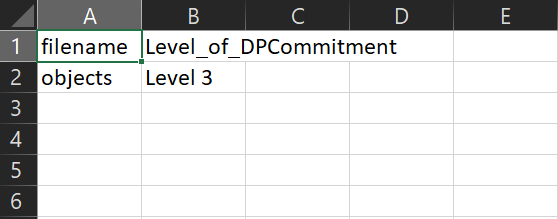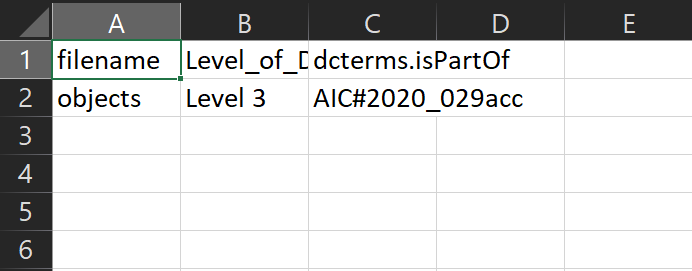...
If you have made changes to the package created with CCA tools (from logical transfer or disk image extraction), such as deleting or changing organization of the packagethe files in the "objects" folder, you will have to make changes to the appropriate checksum.md5 file within the SIP. Making sure it is accurate ensures that Archivematica will be able to check all the files transferred correctly. If not, proceed to step 4.
...
- file: the path that the package/folder/file is located. If describing a restriction of the entire package, this will always be just "objects". In the case of folders or files you will list objects/ first and then the rest of the path. If your content is in a bag, you will need to put /data instead of /objects for folders and files so Archivematica looks in the correct place.
- basis: the basis of restriction, there are three choices we generally use: policy, statute. and donor ("other" is also an option in rare cases where a restriction does not fit those categories).
- status: this should always be "restricted".
- determination_date: the date you determined the statute applied to these records, most likely the present date. It is in YYYY-MM-DD format. This only used for restrictions with the basis: statute. It will allow us in the future to determine what version of the statute was in place at the time of the determination.
- jurisdiction: the jurisdiction where the statute applies, it is not used for the other restriction types. This will be entered using ISO 3166 aplha-2 country codes or subdivision code (often for states), most often used are "us" for United States or "us-ma" for Massachusetts.
- start_date: the start date of the restriction, if on the package or folder level, the oldest dates of a restricted file within the grouping.
- end_date: the end date of the restriction often the restriction time period after the start date (the start date plus 50 years, for instance). If on the package or folder level, this will be the date plus the restriction period of the newest file with a restriction (newest file date plus 50 years, for instance). If the restriction end date is based on a donor policy reliant on an unknown end date (for instance the death of the creator), then this field should be left blank.
citation: the citation to the statute relevant to this description. The most often used are FERPA, MA 201 CMR section 17, and HIPAA. - note: the description of the restriction based on restriction type. For example, "student records, restricted for 75 years".
- grant_act: indicates the type of preservation repository action being described. This will always be "disseminate"
- grant_restriction: indicates the whether the action in step 9 is allowed or not. This will always be "disallow".
- grant_start_date: the same date listed in the first start_date field above.
- grant_end_date: the same date listed in the first end_date field above.
When finished, save a copy of file as a CSV in the “metadata” folder within the package you are transferring in Archivematica.
Info title Note If you have a bag where the “metadata” folder was created within the “data” folder or if you have not determined the restriction status because you are waiting to analyze the files in Archivematica, adding the rights CSV restrictions metadata will wait until a later step in Archivematica and would only be for the entire package (see Archivematica processing step 6 x under Ingest. (this still needs to be added to the documentation (link)). In the case of this type of the bag, adding it to the metadata folder now would cause the bag to be invalid.
- Move onto the Creating and adding the metadata file section.
...
- There is a template included in the Transfer folder that you can edit for your needs, which is titled metadata.csv, this is the same as what the file will be named that you include in the package.
- Open the template, there should be at least two heading columns.
- Column 1 is the “filename”, this should always be “objects”.
- Column 2 is the “Level_of_DPCommitment” which should be the appropriate level for the specific package, such as “Level 3”.
- If you are putting through multiple packages (each with it’s own metadata file) as part of the same transfer (e.g. 2020_029_001, 2020_029_002, etc.), you will need a third column called “dc.isPartOf”. In that field you will enter the identifier for the group of packages, adding “AIC#” to the beginning. For instance, “AIC#2020_029acc”.
Save the file as a copy in the “metadata” folder within the package you are transferring in Archivematica.
Info title Note If you have a bag where the “metadata” folder was created within the “data” folder or if you have not determined the level of digital preservation commitment because you are waiting to analyze the files in Archivematica, adding the CSV metadata will wait until a later step in Archivematica (see Archivematica processing step 6 under Ingest. (link) In the case of this type of the bag, adding it to the metadata folder now would cause the bag to be invalid.
Final steps
Open Archivematica and click “Browse” and make sure the folder is available. Now you can proceed to the Archivematica processing steps (link)
...





